It was a great time for football and even for football card collectors. Mirroring to some extent their baseball counterparts but actually groundbreaking in their own right, 1970s Topps football cards helped keep the sport running at a very high popularity level. Sets issued during the decade include a mix of somewhat late-blooming quarterbacks, offensive record setters and one-card wonders.
The 70s began with the conclusion of the AFL-NFL merger and even though Topps had been making a joint set since 1968, now there was only league and one players association for Topps to negotiate with. By then, it had been five years since the last time a player appeared on a card during his rookie season (and would take almost two decades for the next appearance) and thus we always had to wait at least one season after a player’s actual debut to get our first card of our newest hero.
Below is a list of the most valuable and/or significant football rookie cards of the 1970s. Click the links to see them on eBay.
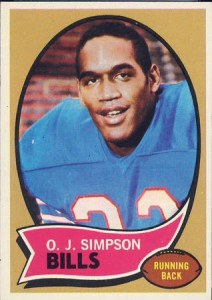 For years, the 1970 Topps O.J. Simpson was one of the premier 1970s football cards. Of course, when O.J. became the first to rush for more than 2,000 yards in just a 14 game season, his legend was set for a long time. After Simpson retired, he continued to remain in the public eye for his television commercials and also for his movie roles. Of course, in the mid-1990s, fortunes changed. Simpson’s cards ended up being worth a lot less after the murder of his wife and Ron Goldman in June 1994. Although not convicted of that crime, Simpson ended up in jail for other legal issues and his popularity has crashed, although you’ll still pay a premium for that rookie card. It’s a reminder of a far more innocent time.
For years, the 1970 Topps O.J. Simpson was one of the premier 1970s football cards. Of course, when O.J. became the first to rush for more than 2,000 yards in just a 14 game season, his legend was set for a long time. After Simpson retired, he continued to remain in the public eye for his television commercials and also for his movie roles. Of course, in the mid-1990s, fortunes changed. Simpson’s cards ended up being worth a lot less after the murder of his wife and Ron Goldman in June 1994. Although not convicted of that crime, Simpson ended up in jail for other legal issues and his popularity has crashed, although you’ll still pay a premium for that rookie card. It’s a reminder of a far more innocent time.
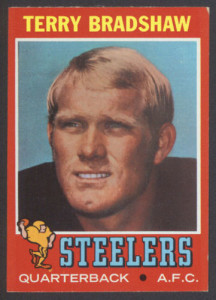 The following year, we had the rookie card of the very first 1970’s draft pick. Terry Bradshaw, who we still see today as a Fox football commentator, was off to a mediocre NFL start after a rough 1970 season. There were plenty of fans who were wishing Terry Hanratty would be a better NFL quarterback than Bradshaw. Within two years, the Steelers were a playoff team and by the conclusion of the 70s they had won four Super Bowls, all with Bradshaw as the starting quarterback. Of course it helped to have a dominating defense and such great running backs as Rocky Bleier and Franco Harris and receivers such as Lynn Swann and John Stallworth but Bradshaw was a key to those teams. In addition, with the colored bordered, the 1971’s are difficult to acquire in high grade. The 1971 Topps Terry Bradshaw is one of the best football cards of the 70s. The rookie card of his teammate, Mean Joe Greene, is also among the best of the decade.
The following year, we had the rookie card of the very first 1970’s draft pick. Terry Bradshaw, who we still see today as a Fox football commentator, was off to a mediocre NFL start after a rough 1970 season. There were plenty of fans who were wishing Terry Hanratty would be a better NFL quarterback than Bradshaw. Within two years, the Steelers were a playoff team and by the conclusion of the 70s they had won four Super Bowls, all with Bradshaw as the starting quarterback. Of course it helped to have a dominating defense and such great running backs as Rocky Bleier and Franco Harris and receivers such as Lynn Swann and John Stallworth but Bradshaw was a key to those teams. In addition, with the colored bordered, the 1971’s are difficult to acquire in high grade. The 1971 Topps Terry Bradshaw is one of the best football cards of the 70s. The rookie card of his teammate, Mean Joe Greene, is also among the best of the decade.
R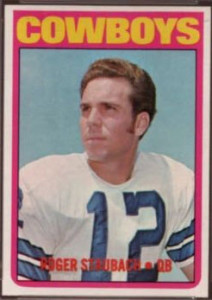 oger Staubach had been a fan favorite since his Navy days a decade earlier and would also lead the Cowboys to two Super Bowl titles. What makes the 1972 Topps Staubach rookie card more interesting was he had been in the NFL since 1969. With all the publicity some collectors may have wondered why it took the Cowboys winning the Super Bowl for Roger the Dodger to get his first Topps card. Notoriously off-center, this one can be pricey if you’re looking for the best of the best.
oger Staubach had been a fan favorite since his Navy days a decade earlier and would also lead the Cowboys to two Super Bowl titles. What makes the 1972 Topps Staubach rookie card more interesting was he had been in the NFL since 1969. With all the publicity some collectors may have wondered why it took the Cowboys winning the Super Bowl for Roger the Dodger to get his first Topps card. Notoriously off-center, this one can be pricey if you’re looking for the best of the best.
Another card which is interesting in the 1972 Topps set is the Joe Namath In Action high number. While Larry Fritsch, the major dealer of that era, ended up with most of that third series print run, there were a few areas in the country (Notably Dallas-Fort Worth) that actually saw these cards in the candy stores of that time. Today, the whole series is on many collectors’ radar and the Namath in Action is one of the most valuable in the series.
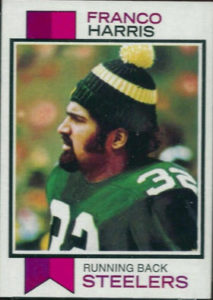 In 1973, Topps put all the cards into one series, which began arriving in stores in late summer. We wonder if Topps was tired of returns of higher series packs in all sports and realized this would help their sell-through. While not quite on the level of the other cards we have mentioned so far the key rookie card was the 1973 Topps Franco Harris. By 1973, the replay of the “Immaculate Reception” was already ingrained in kids and collectors minds and we all wanted a card to be part of Franco’s Army. Ken ‘The Snake’ Stabler’s rookie card is also in the 1973 Topps set.
In 1973, Topps put all the cards into one series, which began arriving in stores in late summer. We wonder if Topps was tired of returns of higher series packs in all sports and realized this would help their sell-through. While not quite on the level of the other cards we have mentioned so far the key rookie card was the 1973 Topps Franco Harris. By 1973, the replay of the “Immaculate Reception” was already ingrained in kids and collectors minds and we all wanted a card to be part of Franco’s Army. Ken ‘The Snake’ Stabler’s rookie card is also in the 1973 Topps set.
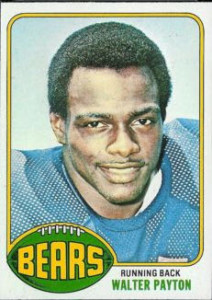 In 1975, we see the first cards of Hall of Famers Swann and Dan Fouts, the prolific Chargers’ quarterback, but in ’76, one of the most popular football cards ever created was emerging from wax, rack, cello and vending.
In 1975, we see the first cards of Hall of Famers Swann and Dan Fouts, the prolific Chargers’ quarterback, but in ’76, one of the most popular football cards ever created was emerging from wax, rack, cello and vending.
Walter Payton would last more than a decade in the NFL and establish the all-time rushing record until Emmitt Smith surpassed it. With the growing emphasis on the pass in the NFL, it is doubtful any back will ever approach Payton’s totals much less Emmitt’s. In addition, the current longevity of NFL running backs is far less as well. Payton is still a revered figure today and fans still love watching the highlights of his career. His 1976 Topps rookie card is one of the most valuable post-War cards.
The following year, we had the rookie card of the greatest 1980’s receiver, Steve Largent. Although Jerry Rice did play the second half of the decade and had a better overall career, Largent would have the best overall decade. In addition, since he and the Seattle Seahawks basically came into the NFL at the same time he became a legend in the Pacific Northwest. When Largent retired he held many major NFL records and his card helped to keep the 1977 set at a high level.
The following year, Tony Dorsett’s rookie card would take center stage. Dorsett came out of Pittsburgh a few years before Dan Marino and led the team to a National title for their first time in nearly 40 seasons. Dorsett was then drafted by the Dallas Cowboys and in his first NFL season they won the Super Bowl as well. By this time, there was a growing collector movement and Dorsett’s rookie card had significant interest just out of the packs and that interest has never slowed down to this very day.
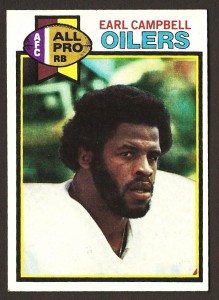 And our tour of the 1970’s conclude with the 1979 Earl Campbell rookie card. Similar to Dorsett, Campbell was a highly sought-after card immediately upon release as he had a rookie season even better than Dorsett’s. What was not known during 1979 was Campbell would never have another Topps card during his playing career and the rookie card, as well as the leaders cards he was on, would be the only cards ever available to both the kids and the collectors of that time. The most reliable story I ever heard about that was Campbell was very serious about his likeness and read through all the contracts very carefully and did not like what he read in the Topps contract. Since today, Campbell has a very successful line of sausage products, there is little doubt that story was probably fairly accurate. Thus if you want an Houston Oilers Earl Campbell card from his playing days, you have only one year to choose from.
And our tour of the 1970’s conclude with the 1979 Earl Campbell rookie card. Similar to Dorsett, Campbell was a highly sought-after card immediately upon release as he had a rookie season even better than Dorsett’s. What was not known during 1979 was Campbell would never have another Topps card during his playing career and the rookie card, as well as the leaders cards he was on, would be the only cards ever available to both the kids and the collectors of that time. The most reliable story I ever heard about that was Campbell was very serious about his likeness and read through all the contracts very carefully and did not like what he read in the Topps contract. Since today, Campbell has a very successful line of sausage products, there is little doubt that story was probably fairly accurate. Thus if you want an Houston Oilers Earl Campbell card from his playing days, you have only one year to choose from.